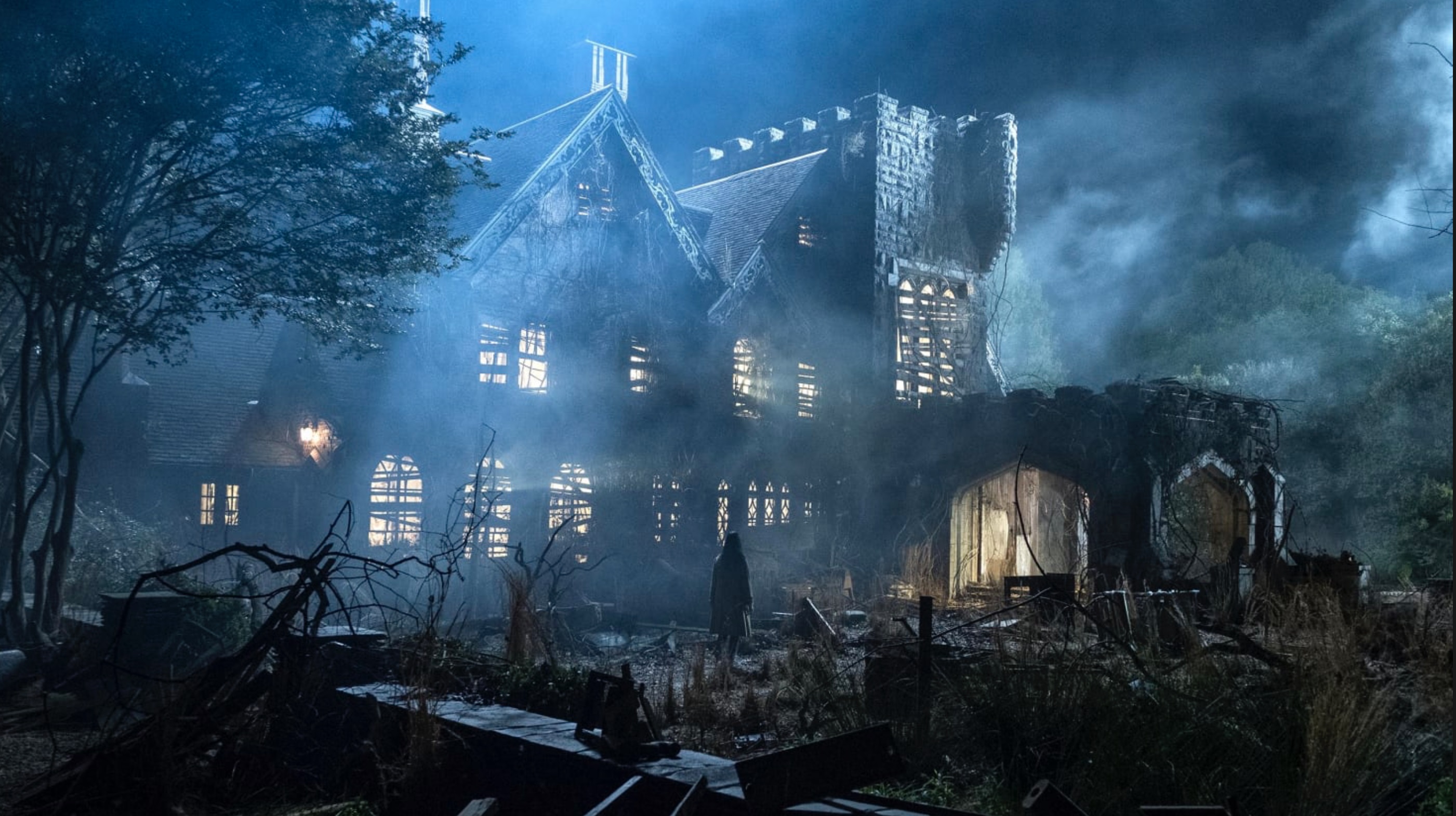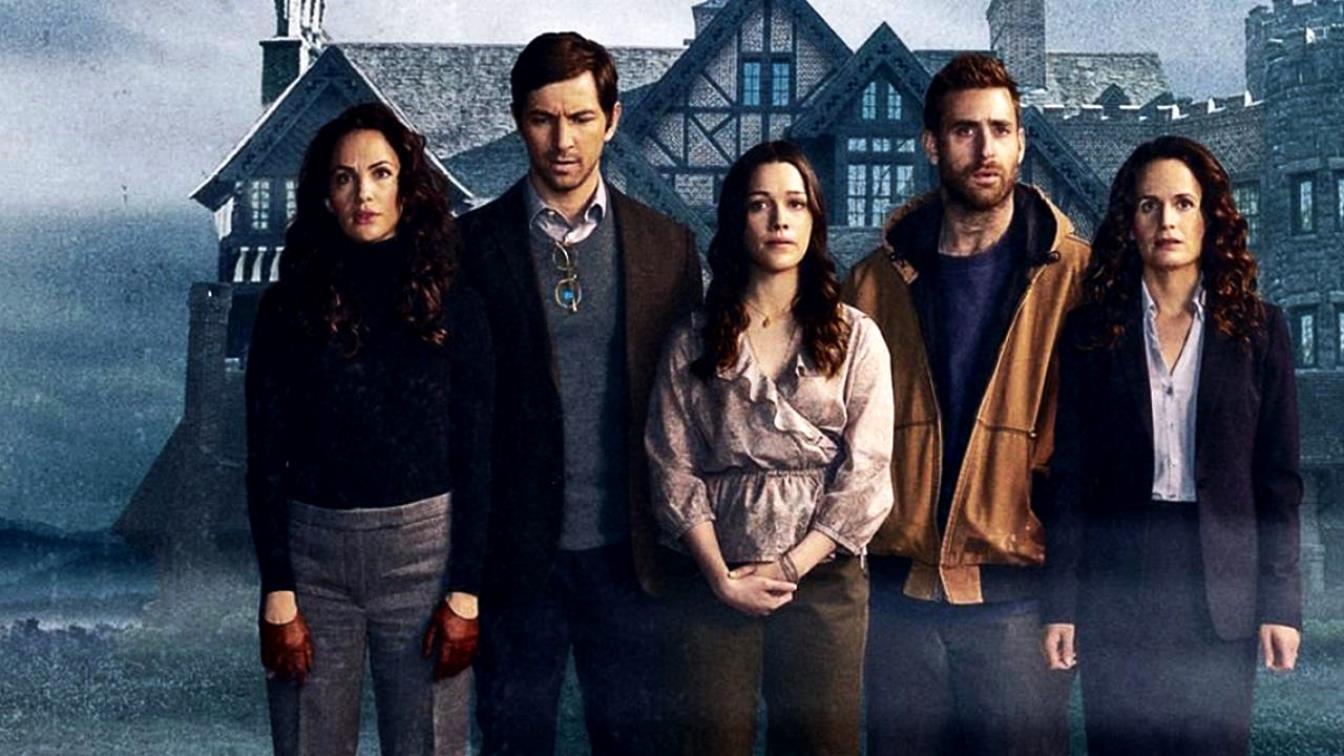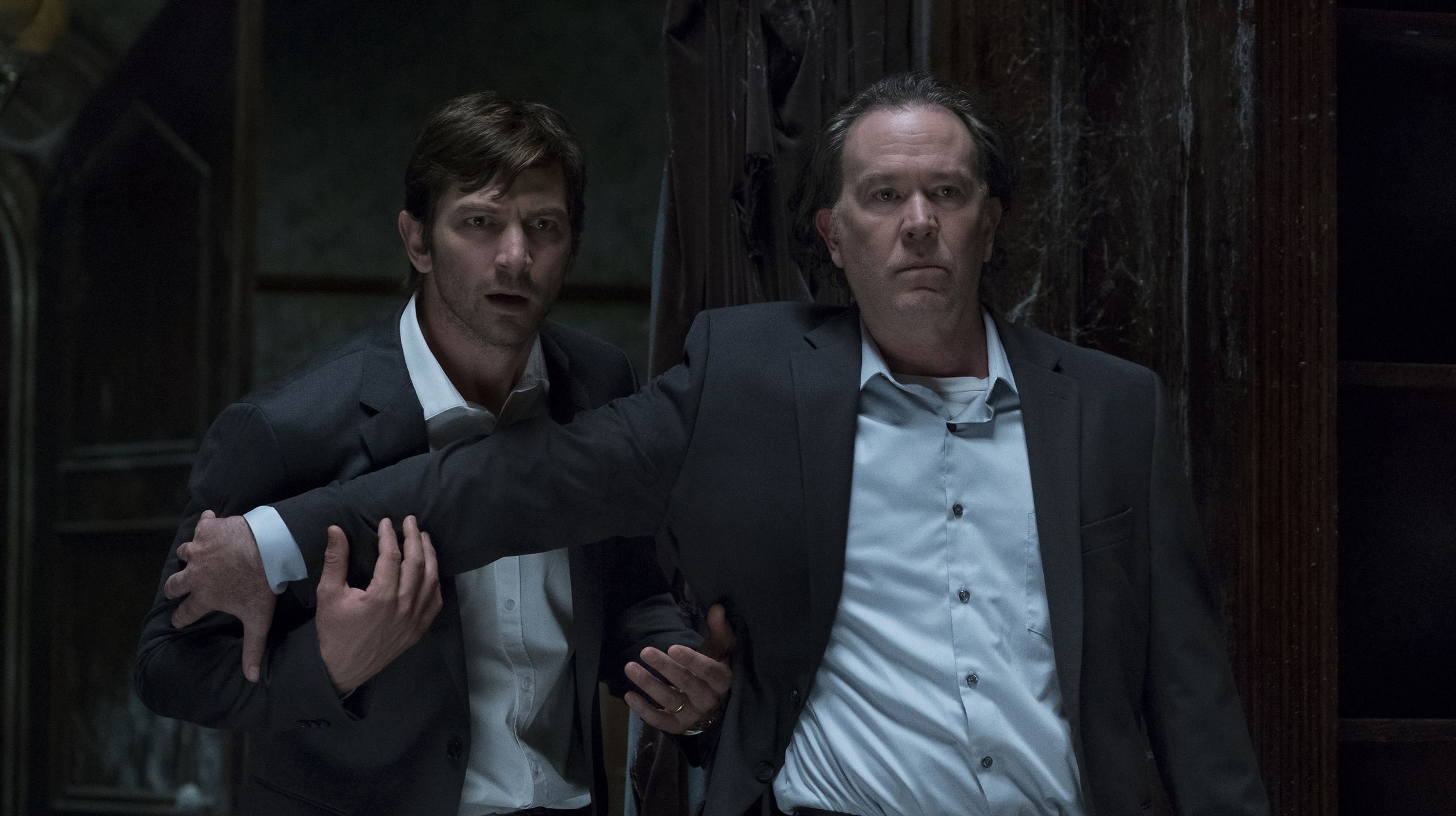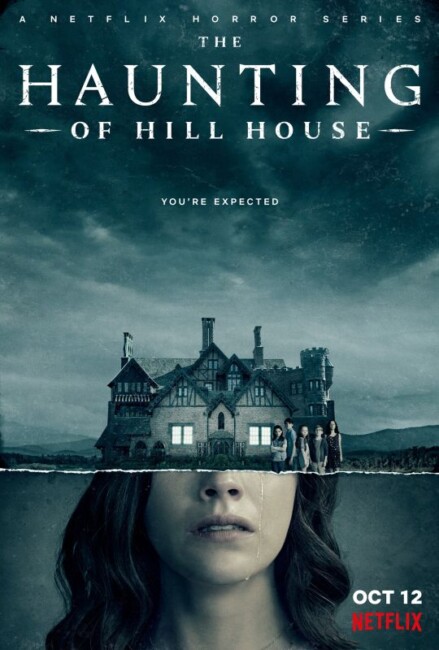USA. 2018.
Crew
Director/Created for Television by Mike Flanagan, Teleplay – (Episode 1, 2 & 10) Mike Flanagan, (Episode 3) Liz Phang, (Episode 4) Scott Kosar, (Episode 5 & 9) Meredith Averill, (Episode 6) Mike Flanagan & Jeff Howard, (Episode 7) Charise Castro Smith & (Episode 8) Jeff Howard & Rebecca Klingel, Based on the Novel The Haunting of Hill House by Shirley Jackson, Producer – Dan Kaplow, Photography – Michael Fimognari, Music – The Newton Brothers, Visual Effects Supervisor – Keith Adams, Visual Effects – Spin VFX, Special Effects Supervisor – Ken Gorrell, Production Design – Patricio M. Farrell. Production Company – Flanagan Film/Amblin Television/Paramount Television.
Cast
Michiel Huisman (Steven Crain), Kate Siegel (Theo Crain), Elizabeth Reaser (Shirley Crain Harris), Henry Thomas (Young Hugh Crain), Carla Gugino (Olivia Crain), Timothy Hutton (Hugh Crain), Oliver Jackson-Cohen (Luke Crain), Victoria Pedretti (Eleanor ‘Nell’ Crain), Lulu Wilson (Young Shirley), McKenna Grace (Young Theo), Julian Hilliard (Young Luke), Paxton Singleton (Young Steven), Violet McGraw (Young Nell), Annabeth Gish (Clara Dudley), Anthony Ruivivar (Kevin Harris), Robert Longstreet (Horace Dudley), Anna Engar (Joey), Samantha Sloyan (Leigh Crain), Levy Tran (Trish Park), Catherine Parker (Poppy Hill), Saidah Arrika Ekulona (Mrs Walker), Selena Anduze (Paige), Russ Tamblyn (Dr Montague), Keith Arthur Bolden (Sheriff Beckley), James Lafferty (Ryan), Elizabeth Becka (Aunt Janet), Olivia Elise Abercrombie (Abigail)
Plot
The five Crain children grew up in the large, rundown Hill House that their father Hugh was trying to renovate in order to resell. This ended when Hugh abruptly took all of them away in the middle of the night, leaving his wife Olivia behind in the house. She was later found dead. As adults, the children still hold the horrors of what happened at Hill House with them. Steven has gone on to a successful career as a writer with a series of books about haunted house, including The Haunting of Hill House based on their experiences, although he himself does not believe in ghosts. Shirley runs a funeral parlour with her husband Kevin Harris. Theodora, who is a touch-sensitive psychic, has become a child psychologist, lives in their guesthouse and engages in a series of casual lesbian encounters. Luke has become a drug addict and struggles through the recovery process, while his twin sister Eleanor or Nell has deep emotional troubles. The others are abruptly shocked at the news that Nell has returned to Hill House and hung herself. As the family come together for the funeral, meeting up with Hugh, who they blame for the death of their mother, for the first time in years, secrets they each keep and how these tie back in to what happened at Hill House come to the fore.
The Haunting of Hill House (1959) is a classic novel from Shirley Jackson (1919-65). Jackson became fascinated after reading the accounts of 19th Century psychic researchers and laid down her own text that became an essential template for the haunted house genre. In Danse Macabre (1981), his analysis of the horror genre, Stephen King cites The Haunting of Hill House as one of the key horror texts and spends some time examining it.
The book was extremely faithfully adapted into the film The Haunting (1963). This is an absolute classic of the genre, particularly in that director Robert Wise conjures an atmosphere of intense spookiness without ever showing any ghosts. Indeed, The Haunting was a key influence on this author after viewing it on tv back in childhood. The film was remade as the abomination called The Haunting (1999), which substituted all of the spooky unseen atmosphere for CGI overkill, and is possibly one of the worst remakes of all time. The Haunting of Hill House, which aired on Netflix in ten episodes running to a total of 9.53 hours, is a further remake. It received enormous acclaim, even a ringing endorsement from Stephen King himself.
Moria has been online since 1999 and we have seen many faces and trends come and go during that time. One of the worthy pleasures of wading through so much crap comes in discovering new talent and watching it develop. Mike Flanagan was one of those I discovered around 2012 with the amazing Absentia (2011), which immediately pegged him as a director to watch out for. Flanagan has not disappointed since then with works such as Oculus (2013), Before I Wake (2016), Hush (2016), Ouija: Origin of Evil (2016), Gerald’s Game (2017) and Doctor Sleep (2019).
I am always sceptical of a work that seeks to remake a classic – and classics (at least in terms of the horror genre) don’t come better regarded than The Haunting does. Every remake is always a fight between updating elements to find a contemporary relevance and staying faithful to the source material – one need look no further than the tv mini-series Picnic at Hanging Rock (2018) that came out five months before The Haunting of Hill House. It very similarly took a feature-length film that had been based on a classic book and padded it out with character backstories that came to overtake and render the central events that took place in the original as no more than a footnote to the story that the filmmakers were far more interested in writing. Both mini-series could be used as textbook examples – Picnic at Hanging Rock was an object lesson in how not to, while The Haunting of Hill House should be held up as an exemplar of how it can be made to work.

I kept wondering as I sat down to watch The Haunting of Hill House just how Mike Flanagan would spin a slim 240 page novel and a 114 minute film out to ten one-hour episodes. There just doesn’t seem enough story in either original to warrant that length – a group of people are brought together by a scientist to investigate a supposedly haunted house; they find it is in fact haunted – The End. Other than a few scenes of Eleanor’s home life in the first film, there are no backstories to speak of to any of the characters. One’s dread was that the mini-series would fall into the same pitfalls as Picnic at Hanging Rock and pad every single beat and jump of the original out with far more weight and drama than it needed.
Watching The Haunting of Hill House, the surprise is that Mike Flanagan dispenses entirely with any story about a team of paranormal investigators venturing into a haunted house. This could well be because the paranormal investigators theme, which first premiered on screen in the 1963 film, has been overdone by just about every other ghost story since – we now even have reality tv shows about ghostsbusters.
The original investigatory team consisted of four characters – shy Eleanor who was venturing out into the wider world for the first time; Theo the psychic who came with just the slight suggestion that she was into girls; Dr John Markway/Montague, the scientist heading the project in the book; and Luke, the family heir who was cynical about everything. Here these four characters are rewritten as five siblings who lived in the house as children and as adults go back to confront the horrors they experienced. They also gain the surname Crain – after Hugh Crain, the original builder of the house in the book, who now becomes the father (played by Henry Thomas and Timothy Hutton at different ages).
Dr Markway no longer exists and the character now becomes Micheil Husiman’s Steven who has written a best-selling book about the family’s experience. Theo (Kate Siegel) now has the freedom to openly be a lesbian and we even see her bedding a woman during the course of the show. Luke is probably the character who bears the least in common with his earlier counterpart and becomes the much more tragic figure of the twin who is haunted by the events and has developed a drug addiction. Victoria Pedretti plays Nell, full name Eleanor, who is no longer shy and venturing out into the world for the first time but is suffering from emotional heartbreaks.

Many other characters pay homage to the original(s). There is the addition of the fourth sister Shirley who has no equivalent in the book or film – her name pays tribute to original author Shirley Jackson, while her married name is Harris presumably in an acknowledgment to Julie Harris who played Eleanor in the 1963 film. Russ Tamblyn (Luke in the first film) also turns up in one episode – the only person involved in the mini-series who has any connection to the 1963 film – playing Nell’s psychiatrist who is named Dr John Montague, the leader of the team of investigators in the book/film. The Dudleys are still present but are boosted from the mere groundskeepers they were in the original to be given considerably more screentime and a backstory that creates surprising sympathy by the time of the final episode.
Mike Flanagan freely rearranges events. The end of the book and 1963 film culminate in Eleanor’s death from the spiral staircase but here Flanagan rearranges events so that Nell’s death in the house is the key event that starts the story off. As we see the original story spun out into a saga that covers the characters both as children and their adult selves who return to face the evil again, you cannot help but think that Mike Flanagan was given orders to go away and replicate Stephen King’s It (1986), which had notedly been remade on the big screen as It (2017) thirteen months before The Haunting of Hill House aired. Certainly, you have to compliment the mini-series for some superlative casting in matching the young actors and their grown-up counterparts
I had issues when it was apparent from the first episode that Mike Flanagan was breaking the unseen ghosts rule – The Haunting 1963 is arguably the most effective cinematic example of this. I am not going to argue that he does something better, although he does give us a number of scares that do regularly cause people to jump out of their couches. To be fair, he does homage many moments from the original – the classic scene with something unseen battering at the door is briefly replayed during the episode set at the funeral parlour (although not with as much effect as Robert Wise did).
The other area that Wise achieved far better was in terms of production design – his Hill House looks a real location with some superbly atmospheric interiors, whereas Flanagan’s Hill House looks only like sets and much of their atmosphere is killed by the colours being desaturated to an unappealing dun grey throughout.

Nevertheless, Mike Flanagan does get some eerie and often highly effective scares of his own off. There is the fine scene in the first episode where Micheil Huisman returns home and is annoyed to find Victoria Pedretti’s Nell there and we realise that she is a ghost before he gets the phone call to inform him she is dead. Or scenes where the young Luke (Julian Hilliard) is playing in the dumb waiter and gets stuck down in the cellar just as the lights go out and something dead and only briefly glimpsed starts crawling towards him. There is the incredibly uncanny image at the start of Episode 4 with young Luke cowering in bed as a tall figure floats into the room, tapping the floor with his cane as it comes up to the bedside table to collect its bowler hat. The one scene that caused me to nearly leap out of my seat however was the one where the ghost appears in the car in Episode 8.
The characters are written with considerable depth. I was glued to the series after Kate Siegel’s Theo opens up to Levy Tran at the end of Episode 3 about why she is emotionally closed off. This is followed by the emotionally gruelling Episode 4 following the adult Luke through rehab that feels written by someone who has an intimate insider knowledge of the Recovery process. Or the heart-shattering scene in Episode 9 where the twins both talk about having dreams that speak of their futures – about Nell whose heart is so broken she cannot live and Luke putting poison in his veins – and Olivia about wanting to wake them up. The scene at the end of Episode 8 when Kate Siegel collapses on the ground and talks about how she felt dead inside after touching Nell’s body and needed to reach out and embrace Shirley’s husband is one of the most emotionally raw scenes I can recall having seen in a film of late.
One of the finest scenes comes in Episode 8, the night before the funeral where the family come together and everything descends into angry recriminations as secrets start to come to the fore. What is notable about this is that another film might allow it to take place in a scene of about two minutes of charged confrontations whereas Mike Flanagan paces and dramatically rides the undercurrents of the scene to draw it out to an hour’s worth of (entirely riveting) screen time. (Flanagan also filmed the scene in three longtakes ie. the camera only cuts away two times throughout plus two flashback scenes).
The series contains some of the finest pieces of writing I have seen in any genre production in some time. The sense as the series finally comes together and secrets of the past and the ways they have affected each of the children throughout their lives and the dangling threads that Flanagan has allowed to play through each episode is outstanding. And the way in which all of this is wound together to give life to Shirley Jackson’s final line from the book in ways that none of the other works have (and arrive at a surprisingly upbeat ending) is exceptional.
Mike Flanagan followed the success of The Haunting of Hill House up with a further mini-series The Haunting of Bly Manor (2020), adapted from another classic ghost story The Turn of the Screw (1898). Flanagan subsequently went on to produce, create and direct episodes of the tv mini-series The Midnight Club (2022) and The Fall of the House of Usher (2023).
The mini-series is based on The Haunting of Hill House (1959), a classic novel by Shirley Jackson (1919-65), a writer of horror, mystery and macabre tales. Jackson’s works have also been adapted into the split personality film Lizzie (1957) and the Gothic mystery We Have Always Lived in the Castle (2018). The only other film adapted from her works to enter into genre territory was the tv movie The Lottery (1996) based on her classic short story set in a town where people are stoned to death after being chosen in a lottery. Shirley (2020) was a biopic based on Jackson’s troubled life.
(Winner in this site’s Top 10 Films of 2018 list. Nominee for Best Director (Mike Flanagan) and Best Adapted Screenplay at this site’s Best of 2018 Awards).
Trailer here


